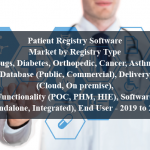OVERVIEW
The Allergy Diagnostics Market is projected to grow significantly from USD 4.8 billion in 2024 to an estimated USD 8.1 billion by 2029, reflecting a CAGR of 11.0% during the forecast period. Allergy diagnostics involves the identification of allergens responsible for allergic reactions using various diagnostic tests such as skin prick tests, blood tests, and challenge tests. The increasing prevalence of allergic diseases, advancements in diagnostic technologies, and the growing awareness of allergy management are driving the market’s growth.
The market’s expansion is also supported by rising healthcare expenditure, increased awareness of early allergy detection, and the integration of advanced technologies such as multiplex assays and point-of-care testing in allergy diagnostics. However, challenges such as high costs of diagnostic tests, stringent regulatory requirements, and the complexity of interpreting test results need to be addressed to sustain market growth.
Geographically, North America and Europe dominate the allergy diagnostics market due to their advanced healthcare infrastructure, significant investments in allergy research, and high adoption rates of innovative diagnostic technologies. The Asia Pacific region is also expected to witness substantial growth, driven by increasing healthcare expenditure, growing awareness of allergic diseases, and the expanding healthcare sector.
Market Dynamics
Drivers:
The primary driver of the Allergy Diagnostics Market is the increasing prevalence of allergic diseases. Allergic conditions such as asthma, allergic rhinitis, food allergies, and eczema are becoming more common worldwide. The rise in pollution levels, changes in lifestyle, and increased exposure to allergens contribute to the growing incidence of allergic diseases. This has led to a greater demand for accurate and reliable allergy diagnostic tests to identify specific allergens and manage allergic conditions effectively. Allergy diagnostics play a crucial role in providing personalized treatment plans, improving patient outcomes, and reducing the burden on healthcare systems. Additionally, advancements in diagnostic technologies, such as the development of highly sensitive and specific assays, are enhancing the accuracy and reliability of allergy tests, contributing to market growth.
Another significant driver is the growing awareness of allergy management and the importance of early diagnosis. Early detection of allergies allows for timely intervention, which can prevent severe allergic reactions and improve the quality of life for patients. The increasing emphasis on preventive healthcare and the availability of advanced diagnostic tools are encouraging more people to seek allergy testing. The integration of advanced technologies, such as multiplex assays and point-of-care testing, is further enhancing the capabilities of allergy diagnostics. These technologies enable the simultaneous detection of multiple allergens and provide rapid results, facilitating prompt and accurate diagnosis. The rising preference for early diagnosis and the continuous advancements in diagnostic technologies are driving the growth of the allergy diagnostics market.
Key Opportunities
The Allergy Diagnostics Market presents numerous opportunities for growth and innovation, particularly in the development and integration of advanced diagnostic technologies. One prominent opportunity lies in the increasing use of multiplex assays. Multiplex assays allow for the simultaneous detection of multiple allergens in a single test, providing comprehensive information about a patient’s allergic sensitivities. The integration of multiplex assays with traditional diagnostic methods is expected to drive market growth by providing more accurate and detailed allergy profiles. Additionally, the use of multiplex assays can facilitate the discovery of novel allergens and improve the understanding of allergic diseases, further enhancing the capabilities of allergy diagnostics.
The growing focus on point-of-care testing presents another lucrative opportunity for the allergy diagnostics market. Point-of-care testing offers several advantages, including rapid results, convenience, and the ability to perform tests outside traditional laboratory settings. Point-of-care allergy tests are becoming increasingly popular due to their ease of use and ability to provide immediate information about a patient’s allergic status. These tests are particularly valuable in primary care settings, where timely diagnosis and intervention can significantly improve patient outcomes. Vendors that invest in the development of point-of-care allergy tests and related technologies are well-positioned to capitalize on this market trend.
Restraints:
One of the significant restraints in the allergy diagnostics market is the high cost of diagnostic tests. The development and deployment of advanced diagnostic technologies, such as multiplex assays and point-of-care testing, require substantial investments in research, equipment, and training. The high upfront costs and ongoing maintenance expenses can be a barrier to adoption, particularly for small and medium-sized healthcare facilities with limited budgets. Additionally, the cost of consumables and reagents used in diagnostic tests further increases the total cost of ownership. To overcome this restraint, vendors need to offer cost-effective solutions and flexible pricing models that cater to the diverse needs of healthcare providers.
Stringent regulatory requirements and the complexity of interpreting test results pose another challenge for the allergy diagnostics market. Diagnostic tests and procedures must undergo rigorous validation and approval processes to ensure their safety, efficacy, and reliability. Compliance with regulatory standards, such as the FDA’s approval process and the European Union’s In Vitro Diagnostic Regulation (IVDR), is essential for market entry and commercialization. The complexity of interpreting test results, which involves the detection and analysis of multiple allergens, further complicates the regulatory landscape. Ensuring compliance with regulatory requirements and maintaining high-quality standards is critical for the successful deployment and operation of diagnostic technologies. Vendors must navigate these regulatory challenges and invest in quality assurance to meet the stringent requirements of the healthcare industry.
Regional Information:
- North America
North America remains a significant market for allergy diagnostic solutions, characterized by advanced healthcare infrastructure, high adoption rates of innovative diagnostic technologies, and substantial investments in allergy research. The region’s strong presence of leading biotechnology and pharmaceutical companies and the high focus on enhancing diagnostic capabilities drive market growth. The increasing prevalence of allergic diseases, such as asthma and food allergies, is propelling the adoption of allergy diagnostic solutions in the region. Furthermore, stringent regulatory requirements and the need for robust diagnostic options encourage healthcare providers to invest in advanced allergy diagnostic technologies. However, the high cost of diagnostic tests and regulatory complexities remain challenges that need to be addressed to fully capitalize on the market potential.
- Europe
Europe leads in the adoption of allergy diagnostic solutions, driven by stringent regulatory requirements, significant investments in healthcare infrastructure, and a strong commitment to improving allergy management. The region’s focus on innovation and technological advancement fuels the demand for advanced diagnostic solutions. Countries like the UK, Germany, and France are at the forefront of implementing allergy diagnostic technologies to enhance diagnostic capabilities and ensure compliance with regulatory standards. The European Union’s regulations, such as the In Vitro Diagnostic Regulation (IVDR), mandate stringent data protection and quality assurance measures, further driving market growth. However, economic uncertainties and the complexity of regulatory compliance necessitate strategic planning and risk management to navigate the market landscape effectively.
- Asia Pacific
The Asia Pacific region is expected to witness the highest growth rate in the allergy diagnostics market due to rapid digital transformation, increasing healthcare expenditure, and the expanding healthcare sector. Countries like China, India, and Japan are investing heavily in allergy diagnostics solutions to support business growth and enhance diagnostic capabilities. The region’s expanding middle class and rising disposable incomes are also contributing to the increasing adoption of allergy diagnostic solutions in various sectors such as hospitals, diagnostic laboratories, and research institutes. Governments in the region are implementing initiatives to promote digitalization and support the growth of the healthcare economy, further driving market growth. However, challenges related to regulatory compliance, fluctuating economic conditions, and the need for skilled healthcare professionals necessitate localized strategies and market insights for successful market penetration.
Recent Developments:
In 2023, Canon has completed share transfer procedures with Resonac Corporation. This share transfer is intended to be used to purchase the Resonac subsidiaries Minaris Medical Co., Ltd. and Minaris Medical America, Inc. (collectively, “Minaris Medical”). After this share acquisition is finished, Minaris Medical—which runs companies that deal with automated analytical tools and in vitro diagnostic reagents—will be consolidated under Canon Medical.
In 2023, Romer Labs Division Holding GmbH (Austria) acquired CPAK INTER Co., Ltd. (Thailand), a long-time distributor of Romer Labs solutions based in Bangkok. With the acquisition, Romer Labs has achieved yet another significant milestone in the quickly expanding Asian food safety industry.
Key market Players:
Frequently Asked Questions
1) What is the projected market value of the Allergy Diagnostics Market?
– The Allergy Diagnostics Market is expected to reach an estimated value of USD 8.1 billion in revenue by 2029.
2) What is the estimated CAGR of the Allergy Diagnostics Market over the 2024 to 2029 forecast period?
– The CAGR is estimated to be 11.0% for the Allergy Diagnostics Market over the 2024 to 2029.
3) Who are the key players in the Allergy Diagnostics Market?
– Thermo Fisher Scientific Inc., Siemens Healthineers AG, Danaher Corporation, bioMérieux SA, HYCOR Biomedical.
4) What are the drivers for the Allergy Diagnostics Market?
– The primary drivers for the Allergy Diagnostics Market include the increasing prevalence of allergic diseases, the growing awareness of allergy management, and advancements in diagnostic technologies. These factors are contributing to the rising demand for allergy diagnostic solutions. The integration of multiplex assays and point-of-care testing is also driving market growth.
5) What are the restraints and challenges in the Allergy Diagnostics Market?
– The high cost of diagnostic tests and stringent regulatory requirements are significant challenges in the market. These factors can limit the adoption of advanced diagnostic technologies. Additionally, the complexity of interpreting test results and ensuring compliance with regulatory standards poses challenges that need to be addressed to ensure effective and secure diagnostic operations.
6) What are the key applications and offerings of the Allergy Diagnostics Market?
– Allergy diagnostics are essential for identifying specific allergens that cause allergic reactions in patients. They enable precise detection and monitoring of allergic conditions such as asthma, allergic rhinitis, food allergies, and eczema. These diagnostics improve patient outcomes by enhancing diagnostic accuracy, enabling early intervention, and facilitating personalized treatment plans. Additionally, allergy diagnostics are crucial in various settings including hospitals, diagnostic laboratories, and research institutes, significantly enhancing the efficiency and effectiveness of allergy management.
7) Which region is expected to drive the market for the forecast period?
– Asia pacific is expected to have the highest market growth from 2024 to 2029
Why Choose Us?
Insights into Market Trends: Global Market Studies reports provide valuable insights into market trends, including market size, segmentation, growth drivers, and market dynamics. This information helps clients make strategic decisions, such as product development, market positioning, and marketing strategies.
Competitor Analysis: Our reports provide detailed information about competitors, including their market share, product offerings, pricing, and competitive strategies. This data can be used to inform competitive strategies and to identify opportunities for growth and expansion.
Industry Forecasts: Our reports provide industry forecasts, which will inform your business strategies, such as investment decisions, production planning, and workforce planning. These forecasts can help you to prepare for future trends and to take advantage of growth opportunities.
Access to Industry Experts: Our solutions include contributions from industry experts, including analysts, consultants, and subject matter experts. This access to expert insights can be valuable for you to understand the market.
Time and Cost Savings: Our team at Global Market Studies can save you time and reduce the cost of conducting market research by providing comprehensive and up-to-date information in a single report, avoiding the need for additional market research efforts.












